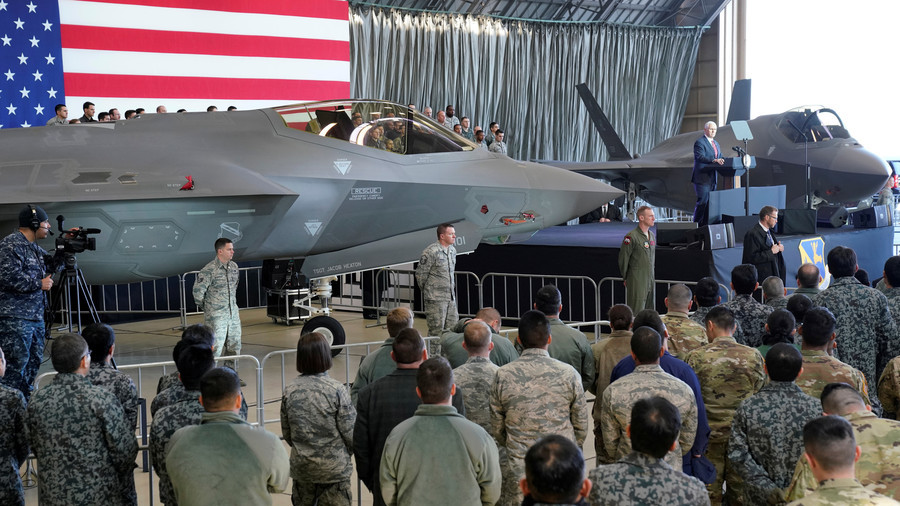Trump tells NATO allies to spend more… like thrifty Pentagon buying $1.2k mugs & $10k toilet seats?

Toilet seat covers that cost $10,000? Coffee mugs for $1,200 apiece? No wonder NATO countries aren’t too keen to follow US military spending benchmarks. Even the Pentagon is looking for better deals and 3D printing for savings.
While President Donald Trump browbeats NATO allies into increasing their military spending, the US Department of Defense is spending untold amounts of taxpayer money on common items it could buy off the shelf or even make in-house, were the military actually allowed to do so.
In one recently reported example, crews of the air tankers and cargo planes based at the Travis Air Force Base in southern California live in dread of dropping the special cups designed to reheat coffee or tea on long flights. The metal cup’s fragile plastic handle is prone to breaking, and there are no replacements to be found, requiring the Air Force to spend up to $1,220 for an entirely new mug.
The 60th Aerial Port Squadron has spent almost $56,000 over the past three years on new mugs, the Air Force Times reported on Monday, describing the drinking vessel as “worth its weight in gold.” Indeed, just this year the USAF spent $32,000 on just 25 cups.
While the Pentagon is still going through its first-ever internal audit, the staggering cost of items such as coffee mugs and toilet seats certainly helps explain where some of that $700 billion-plus in taxpayer funds is going every year.
The root of the problem is that the Pentagon makes bad deals, as Trump might say. When the Department of Defense contracts for purchases, the contracts seldom include intellectual property rights, which allows contractors to charge through the nose for repairs and replacements –or lack thereof– down the road, according to Dan Grazier, former Marine tanker and a fellow at Project On Government Oversight (POGO).
The Air Force could 3D print many components, but it doesn’t own the rights to do so, Assistant Secretary for Acquisition, Technology and Logistics Will Roper told Defense One in May. He brought up the issue of the toilet seat covers for the C-17 Globemaster transports, which cost $10,000 because USAF is not allowed to 3D print them for $300.
“You'll think, 'There's no way it costs that’,” Roper said. “No, it doesn't, but you're asking a company to produce it and they're [busy] producing something else.”
The story has caught the eye, and ire, of Senator Chuck Grassley (R-Iowa), who wrote to the Pentagon’s deputy inspector general in June, saying that “there is no way to justify a $10,000.00 price tag for a toilet seat lid. It’s just not credible. It needs scrutiny.”
As of Tuesday, there has been no response, Grassley’s office said.
When it comes to the coffee mugs, however, the Air Force has finally decided to do something. Captain Ryan McGuire of the 60th Air Mobility Wing turned to designers and engineers in the Phoenix Spark program for a cheaper solution.
“The handle currently on the hot cup has a square bottom which creates a weak point on the handle so any time it is dropped, the handle splits shortly after impact,” said Nicholas Wright, a volunteer 3D designer and printer with Phoenix Spark, according to a Travis AFB release. “Our new rounded handle reduces that weak point. The handle we designed is stronger and capable of being printed at most Air Force bases.”
Now it’s up to the Air Force Life Cycle Management Center at Wright Patterson AFB in Ohio to approve the design, so it can go into production.
It may seem like the US government has never had any sense when it came to contracting, with an oft-quoted myth about NASA spending millions on a space pen while the Soviets used pencils to get around the problem of writing in zero gravity. The actual story is somewhat different, however.
NASA was indeed wasteful in its contracting, paying a Texas-based company $128.89 apiece for some 34 mechanical pencils in 1965. That same year, the Fisher Pen Company patented the “space pen” it researched at its own expense. By 1968, both NASA and the Soviets were buying pens from Fisher in bulk, at $2.39 each, according to Scientific American.




0 Comments:
Post a Comment
Subscribe to Post Comments [Atom]
<< Home